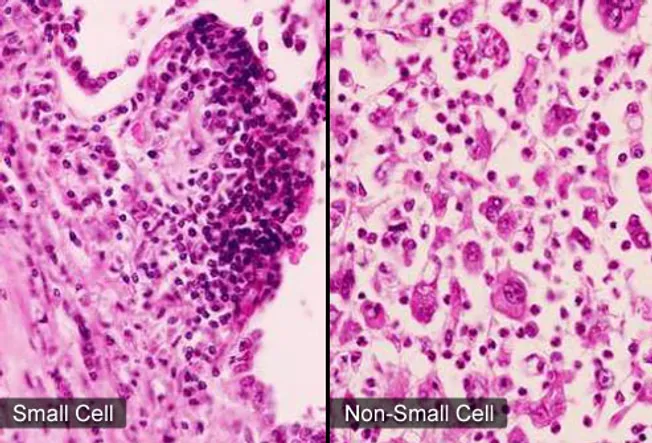Treating Advanced Lung Cancer
When
lung cancer spreads too far to be cured, treatments can still help
patients live longer and have a better quality of life. Radiation and
chemotherapy can shrink tumors and help control symptoms, such as bone
pain or blocked airways. Chemotherapy is usually the main treatment for
small-cell lung cancer.
Targeted Therapies
Targeted
therapies are a newer form of cancer treatment that can be used
together with chemotherapy or when other therapies don't work. One type
prevents the growth of new blood vessels that feed cancer cells. It may
help people with advanced lung cancer live longer. Other targeted
therapies interrupt the signals that cause lung cancer cells to
multiply, as shown in the image here.
Life After Diagnosis
Being
diagnosed with lung cancer can be a shock, and if it's linked to
smoking, you may feel guilty as well. But don't waste time blaming
yourself. Instead, experts suggest looking forward. It's never too late
to make healthy changes to your lifestyle. There's evidence that
patients who quit smoking after learning they have lung cancer do better
than those who keep smoking.
Lung Cancer and Secondhand Smoke
While
smoking is the top cause of lung cancer, it is not the only risk
factor. Breathing in secondhand smoke at home or at work also appears to
raise your risk. People who are married to smokers are 20% to 30% more
likely to develop lung cancer than the spouses of nonsmokers.
Lung Cancer and Work Exposures
Some
jobs can raise the risk of lung cancer in both smokers and nonsmokers.
People who work with uranium, arsenic, and other chemicals should try to
limit their exposure. Asbestos, which was once widely used in
insulation, is a notorious cause of lung cancer. It is rarely used now,
but workers who were exposed years ago are still at risk.
Lung Cancer and Radon Gas
Radon
is a natural radioactive gas that occurs at higher than normal levels
in certain parts of the U.S. The gas can build up inside homes and raise
the risk of lung cancer, especially in people who smoke. It is the
second leading cause of lung cancer in the U.S. About 12% of lung cancer
deaths are linked to radon exposure. The gas can't be seen or smelled,
but can be detected with simple test kits.
Lung Cancer and Air Pollution
While
it causes far fewer cases than smoking, air pollution may raise the
risk of lung cancer. Experts think that pollution from cars, factories,
and power plants may affect the lungs like secondhand smoke does.
Worldwide, air pollution may have caused about 223,000 lung cancer
deaths.
Other Risk Factors for Lung Cancer
They may include:
- A family history of lung cancer
- Drinking water that's high in arsenic
Lung
cancer does happen to people with no well-known risk factors --
including those who've never smoked. Researchers don't know the cause
yet, but lung cancer in nonsmokers appears to affect more women than
men. And one type, adenocarcinoma, is more common in nonsmokers than
smokers.
Prevention
Lung
cancer may be one of the deadliest forms of cancer, but it's also one of
the most preventable. In two words: Don't smoke. And if you do, get the
help you need to quit. Within 10 years of quitting, the risk of lung
cancer will drop 30% to 50%.
THIS IS ONLY FOR INFORMATION, ALWAYS CONSULT YOU PHYSICIAN BEFORE
HAVING ANY PARTICULAR FOOD/ MEDICATION/EXERCISE/OTHER REMEDIES.
PS- THOSE INTERESTED IN RECIPES ARE FREE TO VIEW MY BLOG-
HTTP:GSEASYRECIPES.BLOGSPOT.COM/
FOR INFO ABOUT KNEE REPLACEMENT, YOU CAN VIEW MY BLOG-
HTTP://KNEE REPLACEMENT-STICK CLUB.BLOGSPOT.COM/
FOR CROCHET DESIGNS
HTTP://MY CROCHET CREATIONS.BLOGSPOT.COM



0 Comments:
Post a Comment
<< Home